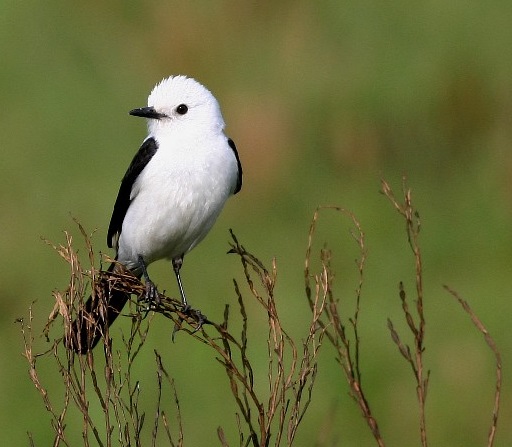m (formatting) |
(→External Links: Fixed multiple searches.) |
||
| (24 intermediate revisions by 7 users not shown) | |||
| Line 1: | Line 1: | ||
| − | + | [[Image:Black-and-white_Monjita_male_by_Jamfaraco.jpg|thumb|550px|right|Male<br />Photo by {{user|Jamfaraco|Jamfaraco}}<br />Lages/SC, [[Brazil]], October 2006]] | |
| − | [[Image: | + | ;[[: Category: Heteroxolmis|Heteroxolmis]] dominicana |
| − | + | ''Xolmis dominicanus'' | |
==Identification== | ==Identification== | ||
| − | + | [[Image:Black_and_White_Monjita.jpg|thumb|300px|right|Female <br />Photo by {{user|Jamfaraco|Jamfaraco}}<br />Lages/SC, [[Brazil]], September 2004]] | |
| + | 20–20·5 cm (7¾-8 in)<br /> | ||
| + | ''' Male''' | ||
| + | *White body | ||
| + | *Black wings and tail | ||
| + | *White wing-tips particularly noticeable in flight<br /> | ||
| + | '''Female''': similar | ||
| + | *Crown, back of neck and back are a brownish-grey | ||
==Distribution== | ==Distribution== | ||
| − | [[Brazil]] | + | South-eastern [[Brazil]] (Paraná) to [[Paraguay]], [[Uruguay]] and north-east [[Argentina]] |
==Taxonomy== | ==Taxonomy== | ||
| − | This is a monotypic species<sup>[[#References|1]]</sup>. | + | This is a [[Dictionary_M-O#M|monotypic]] species<sup>[[#References|[1]]]</sup>.<br /> |
| + | This species was formerly placed in genus ''Xolmis''. | ||
| − | + | ==Habitat== | |
| − | ==Habitat | + | Open areas, fields and humid fields, dry lowland grassland, seasonally wet or flooded lowland grassland, arable land, and pastureland. |
| − | Open areas | ||
==Behaviour== | ==Behaviour== | ||
| − | + | Other species, such as [[Saffron-cowled Blackbird]] likes to be around this species, seemingly because it is good at detecting approaching dangers such as raptors. | |
| + | ====Diet==== | ||
| + | Their diet consists almost entirely of insects. They feed on the ground, dropping from a low perch onto their prey. | ||
====Vocalisation==== | ====Vocalisation==== | ||
| − | + | [[Image:Blackandwhite MonjitaXP.jpg|thumb|350px|right|Photo by {{user|Xyko+Paludo|Xyko Paludo}}<br />Cambará do Sul, RS, [[Brasil]], November, 2017]] | |
| + | Mostly silent. Occasionally delivers soft calls. | ||
==References== | ==References== | ||
| − | # | + | #{{Ref-Clements6thAug21}}#{{Ref-HM04}}#{{Ref-GillDonsker15V5.3}}#BirdLife International |
| + | #Krüger & Petry (2010). Ornitologia Tropical 21(2): 299-303 | ||
| + | #Handbook of the Birds of the World Alive (retrieved Dec 2017) | ||
| + | {{ref}} | ||
==External Links== | ==External Links== | ||
| − | {{GSearch|Xolmis | + | {{GSearch|"Heteroxolmis dominica" {{!}} "Black-and-white Monjita" {{!}} "Xolmis dominicanus" }} |
| − | [[Category:Birds]][[Category: | + | {{GS-checked}}1 |
| + | [[Category:Birds]] [[Category:Heteroxolmis]] | ||
Latest revision as of 14:46, 14 May 2023
- Heteroxolmis dominicana
Xolmis dominicanus
Identification
20–20·5 cm (7¾-8 in)
Male
- White body
- Black wings and tail
- White wing-tips particularly noticeable in flight
Female: similar
- Crown, back of neck and back are a brownish-grey
Distribution
South-eastern Brazil (Paraná) to Paraguay, Uruguay and north-east Argentina
Taxonomy
This is a monotypic species[1].
This species was formerly placed in genus Xolmis.
Habitat
Open areas, fields and humid fields, dry lowland grassland, seasonally wet or flooded lowland grassland, arable land, and pastureland.
Behaviour
Other species, such as Saffron-cowled Blackbird likes to be around this species, seemingly because it is good at detecting approaching dangers such as raptors.
Diet
Their diet consists almost entirely of insects. They feed on the ground, dropping from a low perch onto their prey.
Vocalisation
Mostly silent. Occasionally delivers soft calls.
References
- Clements, J. F., T. S. Schulenberg, M. J. Iliff, S. M. Billerman, T. A. Fredericks, J. A. Gerbracht, D. Lepage, B. L. Sullivan, and C. L. Wood. 2021. The eBird/Clements checklist of Birds of the World: v2021. Downloaded from https://www.birds.cornell.edu/clementschecklist/download/
- Dickinson, EC, ed. 2014. The Howard and Moore Complete Checklist of the Birds of the World. 4th ed. Princeton: Princeton Univ. Press. ISBN 978-0956861122
- Gill, F and D Donsker (Eds). 2015. IOC World Bird Names (version 5.3). Available at http://www.worldbirdnames.org/.
- BirdLife International
- Krüger & Petry (2010). Ornitologia Tropical 21(2): 299-303
- Handbook of the Birds of the World Alive (retrieved Dec 2017)
Recommended Citation
- BirdForum Opus contributors. (2024) Black-and-white Monjita. In: BirdForum, the forum for wild birds and birding. Retrieved 19 April 2024 from https://www.birdforum.net/opus/Black-and-white_Monjita
External Links
GSearch checked for 2020 platform.1






